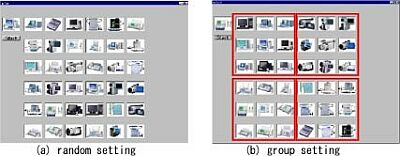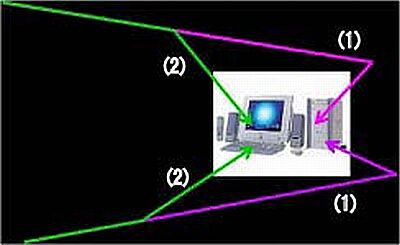
Measuring eye movements and mouse-pointing patterns using thumbnail images
H.M. Masuda, K.I. Ichikawa, K.G. Go and A.I. Imamiya
Department of Computer Science and Media, Yamanashi University, KOFU, Yamanashi, Japan
A two-dimensional arrangement of small images is used to display a number of pictorial data on a computer screen, which is limited in area. These small images, sometimes called thumbnail images, are frequently used in graphical user interfaces like e-commerce web sites and digital photo viewers. The behavioral patterns of users searching thumbnail images, however, have not yet been analysed for comparison with those produced by users searching pull-down menu items [1]. Thus, this paper reports an experiment recording users' search patterns of thumbnail images.
Experiment
An experiment was conducted to compare the search patterns of two types of thumbnail
images: random setting and group setting. In the random setting, thumbnail images
of 36 home appliances were selected and arranged in a random order in a 6 x
6 grid (Figure 1a). In the group setting, the same 36 images were categorized
and arranged into four 3 x 3 sub-areas within the 6 x 6 grid (Figure 1b). The
experimental task was to search for and click on a target image. Data on the
subjects' eye-tracking and mouse-pointing were recorded to obtain a general
behavioral pattern of their searching technique.

Figure 1. Screenshots showing the two settings of thumbnail images.
The point of gaze was recorded using an EMR-HM8 head-mounted eye-tracking device (NAC Image Technology, Inc.; Figure 2). The datalogger of this device connects to the RS232C serial port of a PC, transmitting all recorded data for analysis. Initial analysis was made with our original software, coded in Microsoft Visual Basic. This software records the user's mouse movements and eye-tracking data every 10 ms. In addition, it calculates fixation points from the eye-tracking data. A threshold level for fixation was assigned as 120 ms.

Figure 2. Eye tracking device by NAC Image Technology.
Results
The recorded data show three general patterns. First, the path of the subject's
mouse movement is corrected near the target image. This path of mouse movement
correction has two patterns: (1) over movement and (2) under movement (Figure
3). Second, the user starts moving the mouse after finding the target image.
This pattern is similar to the result of Smith et al. [2]. Finally, in
the group setting, users fixate on points in all four sub-areas to the same
extent.

Figure 3. Mouse correction patterns.
Conclusion
Our software successfully coordinated eye-tracking data and mouse movement data for analysis. The data showed three patterns of visual searching of thumbnail images. This finding is a first step towards developing a general theory of searching thumbnail images for graphical user interfaces.
References
Paper presented at Measuring Behavior 2002 , 4th International Conference on Methods and Techniques in Behavioral Research, 27-30 August 2002, Amsterdam, The Netherlands